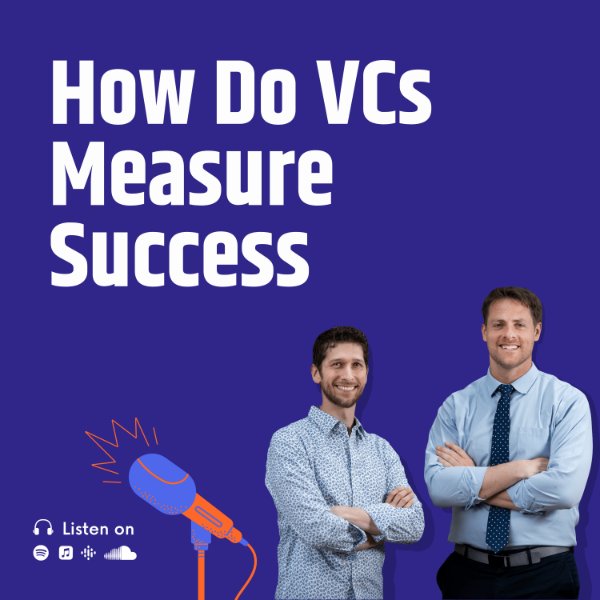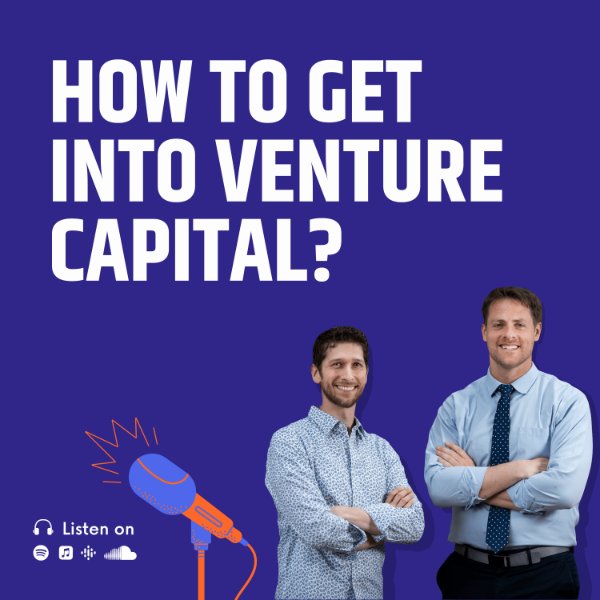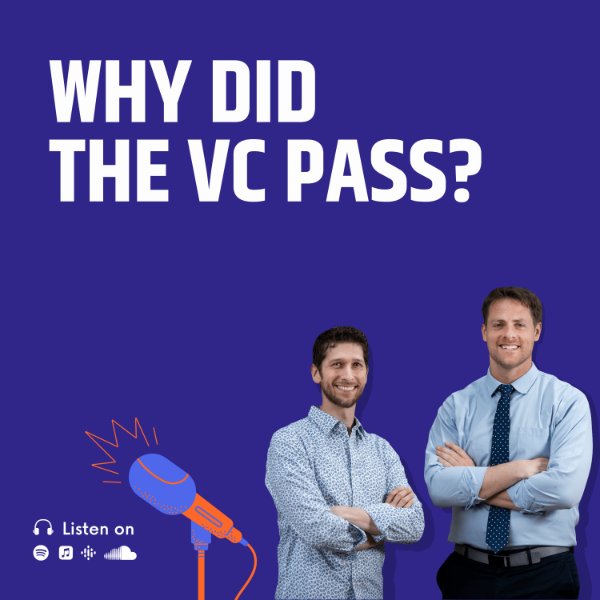Jon: Today on the Venture Capital podcast, we are going to talk about how to get and keep a VCS attention.
Jon: And so I want to start off with asking you, Peter, what are some of the ways that startups and entrepreneurs have gotten your attention or the attention from some of your friends?
Peter: Yeah, So I'll tell you right now, the thing that gets my attention is traction. So if an entrepreneur, even on a cold, call him. If they hit me up and they're like, Hey, we have accomplished this. And it's interesting traction that gives me confidence that they've hit some level of product market fit, I'll pay attention.
Jon: So my favorite intro, when I help my friends raise for their funds and I introduce my friends to their startups, the email is literally just two lines. So let's just talk about Garrett G. Because he's one that's fairly popular. Okay. Hey, Peter Harris, meet Garrett G. He's an entrepreneur and he has 40,000 download the day on his app.
Jon: I think it would be good for the two of you to connect. And that's all I say.
Peter: Now, I like your approach. I think that works. I mean, it's interesting to an extent, but it's also a question of like, Well, but like, how does that really translate? What are they doing? I might take the meeting because I know you and I trust you.
Peter: So there's a ton of value there.
Jon: Would it be, hey, here's an abridged version of our pitch deck that is like three slides.
Peter: Yeah, that could work. Or even even though.
Peter: Five bullet points. So, for example, like, we just took one of our portfolio companies to our our investors to give them the opportunity to co-invest alongside us. And my email to them was a short little paragraph to describe what the company did. I hit them with like five bullet points on traction and kind of sort of our investment thesis about why we were excited about it and then just capped it out with like, Yeah, here's a link to the deck and the diligence.
Peter: Let me know if you're interested and or have questions. Right. I think that sort of thing can be really effective. Your bullet points though, again, like need to hammer home traction or something super impressive and unique things that you have done and accomplished. Yeah, it could be like you you were able to land a super compelling hire to come out of the team like it could be a lot of those different things.
Peter: The things that kind of bug me is when people will put on those bullet points like, Well, the market's really big. And it's like, okay, great. Like if I.
Jon: Had 1% of Chinese market in this in this vertical.
Peter: Or like we anticipate doing this much in revenue in year five and it's like, okay, like I don't even know what I'm going to be doing in year five, so that stuff's not super compelling to me.
Jon: So you're just like, really, it's just five bullet points of traction is what you want in an email that you receive. Yeah, we recruited this person. We have prior experience of X if you're like if you're a pre-seed, if you're seed, you know, we've gone from 0 to 10000 a month at Morar in the last 12 months.
Peter: And a short discussion about what you do, because it could be that like if somebody reached out to me and said, Hey, we're mad device company solving, blah blah blah, I don't even care about the other five bullet points because we don't do med device investing, It doesn't mean that it's a bad company. It's just like not a fit for us.
Peter: And so it's an immediately like it's an immediate like, no, that's that's not really a fit for us right now.
Jon: Getting your attention is probably a little different because typically the University growth fund doesn't lead deals. And so the signals that you're looking for are different from a regular B.S. So you're looking for, hey, is a deal oversubscribed with VCs that are reputable and that's your signal to go in sometimes?
Peter: I mean, yeah, that's a really strong signal if there's a lot of other voices that are interested. But look, we look at a lot of deals that don't have a lead yet, and if it's an interesting enough deal, we'll make introductions to funds that we work with. We've done that successfully a number of times.
Jon: What are examples of taglines or like bullet points that have made an email stand out?
Peter: Well, for us, like most of what we do is like series A, right? Yeah. So I'm looking for a 1 to 3 million minimum. And there are, depending on the business, the things that would catch my attention. Who's invested in the deal already in the past. Right. Because it's not so much because like, well if Sequoia did it, like that must be a great deal.
Peter: That's not necessarily how we think about it. It's more like Sequoia sees a lot of deals, and if they decided to invest in yours out of all of the deals that they could have done, then that probably is a signal that this is this there's something unique and special here. I've also passed on deals that top tier venture funds have backed because, you know, that was enough to get my attention, but not enough to get me across the finish line right.
Peter: But that can be really helpful. Like who else is coming in the deal like notable angels, investors, strategic partners, things like who did you bring on the team or who is on the team? Right. And the more impressive they are, that can solve a lot that that can get me really excited.
Jon: Okay, so you then set up the meeting. How else are they keeping your attention through the process? They just continue to to reveal more and more traction.
Peter: Well, for us, our process is we hear the pitch, we ask questions, if it sounds like is something that that's kind of a fit for what we do, then I'll ask for a data room and then we set up follow up calls. The entrepreneurs that I think have done a really good job of kind of keeping me excited and keeping the momentum going.
Peter: They're constantly updating me on like what's going on and to a certain extent, like they're they're building a little bit of that FOMO that we've talked about on other podcast, right? Like how do you build that? Well, FOMO is all about momentum, right? And if you're staying in touch with your investors and you're keeping them up to date on like how the round is coming together and who's interested and who you're having meetings with, and then like you're also weaving in like, Hey, we just brought on this, this new person to be head of blah, blah, blah, and like, they're amazing.
Peter: Or we just closed this client, right? You're creating momentum. And so, like, I love that, right? I love getting those updates and being part of the process throughout I think is interesting. I think the other thing is like like VCs generally love helping entrepreneurs, right? I love helping entrepreneurs. And so when an entrepreneur comes in, they like they want to engage with me earlier on and together we're already like working on ways to be helpful.
Peter: That's also another way to keep me engaged.
Jon: Isn't that a pseudo thing or that it's the trick? If you want money, ask for advice, and if you want advice, ask for money.
Jon: But you can also see through that. Hey, Peter, I've got this idea. I don't know how to how do I get to my next big deal? And then you would say, Well, what are your other deals looking like? You know, can you actually land this deal? And it creates the conversation.
Peter: I mean, yeah, I mean, everybody can kind of look through, right?
Jon: Or do you prefer that someone just comes in, Hop here. I want 10 million from you.
Peter: I mean, look, I tend to prefer things that are more direct because all they want is advice, and I'll just give them advice. And if they come in and they come in hot and they're like, Hey, I want $10 million and it's not a fit for us, I'll just give them advice.
Jon: How many people who want funding are like, I'll just happen to be in town on this day? Peter You want to meet up? You get that a bunch or.
Jon: Okay. That's what I used to do. You know, as a student, I was trying. I was trying to raise. I was like, I'm just happened to be up in San Francisco.
Peter: And then they said, Yeah, sure. And then you'd book your flight. Yeah, Yeah.
Jon: Do you ever get bribed or gifts? Is that a common thing?
Peter: Well, I did get a bag of, some bags of chips and salsa from, I guess, from my company.
Jon: Okay, There we go. Was that part of their model, though, or separate?
Peter: I mean, that's what they sells the product.
Jon: Okay, So then it's very appropriate. How much of keeping your attention is also them being in an interesting or new or emerging market that's growing?
Peter: for sure. Right. Yeah. And that's why I like having some details about what the company does is interesting too, because it's like, we're like a martech firm. It's like, I'm tired of martech firms, maybe right as a fund, but. And maybe they're like, we're like, we're way into web3 and crypto and, like, maybe our fund doesn't do that.
Peter: Maybe it does, right? Like, so I mean, that, that matters for sure.
Jon: What are some good examples of don'ts Like don't like you're saying don't give weekly updates. Don't give monthly updates probably quarterly.
Peter: Yeah. Don't don't be like overly frequent and don't be overly long. Okay. For updates.
Jon: Any other tips, Peter, on how to get a VCS attention?
Peter: I know we've talked about this a little bit on other podcasts, but and this isn't anything unique, but getting people that are reputable to make those introductions is going to go a long way, right? And it's going to do that for a number of reasons. One, they're lending their credibility to you, right? And so it's like if you make an intro, John, like I have a lot of confidence and respect for your, your judgment, right?
Peter: So anything you send me, like I'm going to at least have a conversation with them right on top of that, like we're good friends. And so if you send me something like, I'm going to feel a little bit obligated to look at it, right? Because I don't want you to have egg on your face of like, Hey, I made this intro.
Peter: And then Peter, like, totally dropped the ball and like, you know, now I look like an idiot in front of the entrepreneur. All right.
Jon: That worked out well. I mean, you invested in Carter because of my intro.
Peter: That's true. Crushed it. Crushed it.
Jon: All. That was for today's podcast on how to get a VCS attention and keep it. Thanks for this advice, Peter. I know I learned some stuff. I probably would have said, Hey, there should be a pitch deck or like, I just like your five bullet points. What are your five most interesting points of traction? Because I think when you look at all of these, these software apps that keep track of like what slides VCs look at, it's it's it's the traction and who is the team.
Peter: Yeah. Look and I think paychecks can be helpful. I like I love flipping through pitch decks everybody sees a little bit different to like I love hearing origin stories. When I meet with an entrepreneur, it's like, tell me the story of how you got to where you're at, right? Like, how did you come up with the idea? Prove to me that, like, this is more than just like a get rich quick scheme that you're, you're pedaling.
Peter: It's something you're truly passionate about. You put a lot of energy into it. You've got some unique knowledge and experience you bring to the table. Like all of those things, like Get me excited. A good entrepreneur is able to help a VC get conviction at the end of the day, and good VCs can get conviction and lead deals right?
Peter: If you're not getting an investor to lead your deal and they are the type of fund that could lead it, it's because they don't have conviction in your deal. And that's either because, like your deal is not the kind that can that deserves conviction or you have not done a good job helping the VC gain that conviction.
Jon: Okay, Well, it's good. Thanks for sharing, Peter. Make sure you like subscribe if you're listening to us on YouTube. Subscribe below. Run Spotify, iTunes. I know Peter would really appreciate if you would leave him a six star review here if you're listening to us on Apple Podcasts. So thanks for watching and join us next time.
Peter: We'll see you next time.






